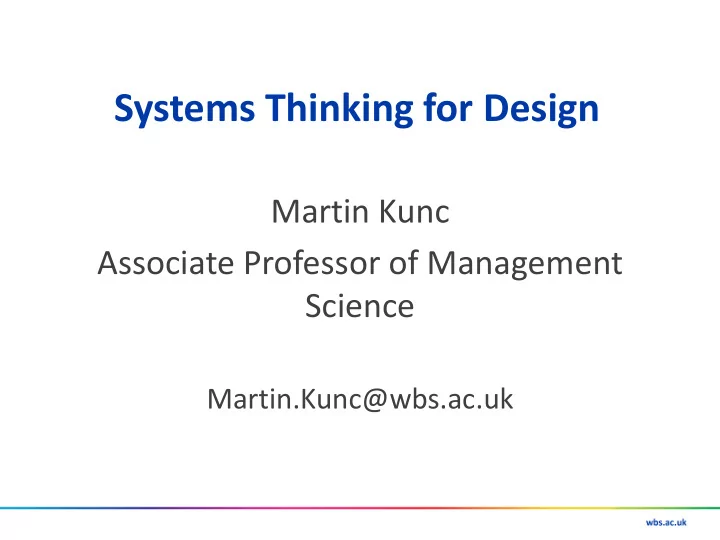

Systems Thinking for Design Martin Kunc Associate Professor of Management Science Martin.Kunc@wbs.ac.uk
A bit of history Cross (2001) suggests the 1960s was the ‘design science decade’ based on science, technology and rationalism to overcome the human and environmental problems that he believed could not be solved by politics and economics. System Dynamics (SD) also started in 1960s in the MIT with similar ideas: the use of control theory to design social and economic policies to improve the performance of systems. Warwick Business School
A bit of history Many of the principles Forrester articulated were targeted to modelling the design of corporations, especially in the seminal book “Industrial Dynamics”. Industrial Dynamics (1960) contributed with a set of four principles for modelling of complex systems: counter-intuitive system behaviour is driven by system structure, structure involves non-linear relationships, simulation is necessary to explore behaviour, and the application of the principles provides a way for managers to improve the design of organizations. Warwick Business School
A bit of history Herbert Simon in “Sciences of the Artificial” made a specific plea for the development of ‘a science of design’ in the universities: ‘a body of intellectually tough, analytic, partly formalisable, partly empirical, teachable doctrine about the design process.’ Forrester, the founder of SD, has also made a plea in the fiftieth anniversary of SD to have “universities of social system design” based on the principles of System Dynamics. Warwick Business School
Two areas to explore from SD in this presentation: System Dynamics as a body of intellectual, analytical and teachable doctrine about the design of social systems. System Dynamics supporting the process of design addressing project management dynamic issues, especially “rework cycle” Warwick Business School
System Dynamics as a tool for the design of social systems www.neilengineering.co.uk Warwick Business School
System Dynamics as a tool for the design of social systems SD has been successfully embedded in a masters programme for sustainable resource management (Biber and Kasperidus, 2004). Kunc and Morecroft (2007) discuss SD modelling for strategic rehearsal to help people understand how strategies will perform over time, and what type of interventions can improve performance. Some authors have developed “archetype models”, simple models, yet conceptualised through real cases to illustrate a key driver of the structure of dynamic complex systems: feedback loops Warwick Business School
System Dynamics as a tool for the design of social systems Modelling is perceived as a tool for conceptual development as students articulate the problem and question the elements and linkages related to the problem. Students improve their skills for designing organisations by understanding the strategic problem in terms of resources and feedback processes (Kunc, 2012). When students change variables and linkages, they improve their mental models and the simulation helps them to learn how the new structure drives behaviour (Schaffernicht, 2006) Warwick Business School
System Dynamics as a tool for the design of social systems Main objectives in teaching SD as a tool for designing Use of time series to understand the behaviour over time of system Identification of the structure of the system responsible for the behaviour observed in terms of feedback loops Being able to replicate the behaviour observed using a simulation model Explain the impact of changes in the design of the structure of the system Warwick Business School
Project management dynamic issues The impact of the design errors is one of the important issues related to factors generating project changes. Uncertainty propagates in a project as each activity is influenced by/influences other upstream and downstream activities. Uniqueness, complexity, and uncertainty lead to significant cost and schedule over-runs across many projects. There is a rich literature in system dynamics that covers project modelling in general (Lyneis and Ford 2007) with particular contribution in the rework cycle formulation (Sterman 2000). Warwick Business School
Project management dynamic issues Formulating the multi-phase project models were discussed in detail by (Ford & Sterman, 1998) in the semiconductor industry and many applications have used different variants of this formulation (Khoueiry, Srour, & Yassine, 2013). Warwick Business School
Conclusions SD can provide a useful platform to explore the social dimensions and long term performance of the outcomes of design processes through “designing the social system” supporting the new designed product/service. SD can help making the process of design more efficient by detecting issues in the design process that requires further resources to address. Warwick Business School
Questions Martin.Kunc@wbs.ac.uk Warwick Business School
References Biber P, Kasperidus HD. 2004. Integrated modeling approaches and system dynamics in education related to sustainable resource management, forestry and land use management. In Proceedings of the 22nd System Dynamics Conference, Oxford, UK. Cross, Nigel (2001). Designerly ways of knowing: design discipline versus design science. Design Issues, 17(3), pp. 49 – 55. Ford, D. N., & Sterman, J. D. (1998). Dynamic modeling of product development processes. System Dynamics Review, 14(1), 31 – 68. Forrester, J. W. (1961). Industrial Dynamics. Lyneis, J. M., & Ford, D. N. (2007). System dynamics applied to project management : a survey , assessment , and directions for future research, 23(2), 157 – 189. Khoueiry, Y., Srour, I., & Yassine, A. (2013). An optimization-based model for maximizing the benefits of fast-track construction activities. Journal of the Operational Research Society. Warwick Business School
References Kunc M, Morecroft J. 2007. System dynamics modelling for strategic development. In Supporting Strategy: Frameworks, Methods and Models, O’Brien F, Dyson RG. ( eds). Wiley: Chichester; 157 – 190. Kunc, M. (2012). Teaching strategic thinking using system dynamics: lessons from a strategic development course. System Dynamics Review, 28(1), 28-45. Schaffernicht M 2006. Detecting and monitoring change in models. System Dynamics Review 22(1): 73 – 88. Simon, H A . (1969), The Sciences of the Artificial, MIT Press, Cambridge, Mass. Warwick Business School
Recommend
More recommend